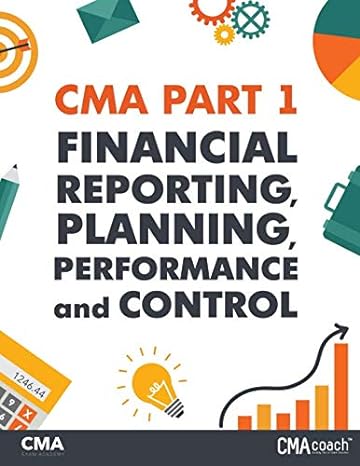Answered step by step
Verified Expert Solution
Question
1 Approved Answer
Required information Applying Power BI Analytics 11-01 (Static) Volume Trade-Off Decisions [LO11-5] [The following information applies to the questions displayed below.] Rollins Company manufactures two
Required information Applying Power BI Analytics 11-01 (Static) Volume Trade-Off Decisions [LO11-5] [The following information applies to the questions displayed below.] Rollins Company manufactures two products-$500 and T750. The company provided the following information with respect to these products: Estimated customer demand (in units). Selling price per unit Variable expense per unit $500 5,600 $ 2,400 $ 1,400 T750 4,000 $ 4,200 $ 2,400 The company has four manufacturing departments-Fabrication, Molding, Machining, and Assemble & Pack. The capacity available in each department (in hours) and the demands that one unit of each of the company's products makes on those departments is as follows: Fabrication Molding Machining Assemble & Pack $500 (hours per unit) T750 (hours per unit) Capacity (in hours) 1 2 4,000 2 2 6,000 5,000 4,500 2 The company is trying to decide what product mix will maximize profits. Given that its fixed costs will not change regardless of the chosen mix, the company plans to identify the product mix that maximizes its total contribution margin. Applying Power BI Analytics 11-01 (Static) Part 1 Required: 1. Assume the company focuses solely on producing S500: a. Which department would be the constraint? (Hint: Focus on each department's capacity (in hours) divided by $500's "hours per unit" within each department.) b. What is S500's contribution margin per hour of the constraining resource that you identified in requirement 1a? (Hint: Calculate $500's contribution margin per unit and divide it by the "hours per unit" for the department you identified in requirement 1a.) 2. Assume the company focuses solely on producing T750: a. Which department would be its constraint? (Hint: Focus on each department's capacity (in hours) divided by T750's "hours per unit" within each department.) b. What is T750's contribution margin per hour of the constraining resource that you identified in requirement 2a? (Hint: Calculate T750's contribution margin per unit and divide it by the "hours per unit" for the department you identified in requirement 2a.) 3. Based on the answers to requirements 1 and 2: a. Which product has the highest contribution margin per hour of its constraining resource? b. If the company decided to initiate production by maximizing the output of the product chosen in requirement 3a, then how many units of this product would it be able to make before encountering that product's constraint? c. If the company implemented the production plan in requirement 3b, then how many units of its remaining product could it make with the departmental capacities that are still available? d. What total contribution margin would the company earn if it followed the production plan described in requirements 3b and 3c? Req 1 Req 2 Req 3a Req 3b to 3d 1. Assume the company focuses solely on producing S500: a. Which department would be the constraint? (Hint: Focus on each department's capacity (in hours) divided by S500's "hours per unit" within each department.) b. What is S500's contribution margin per hour of the constraining resource that you identified in requirement 1a? (Hint: Calculate $500's contribution margin per unit and divide it by the "hours per unit" for the department you identified in requirement 1a.) 1a. The constraining department is 1b. Product S500's contribution margin per hour is Reg1 Req 2> Show less A Complete this question by entering your answers in the tabs below. Req 1 Req 2 Req 3a Req 3b to 3d 2. Assume the company focuses solely on producing T750: a. Which department would be its constraint? (Hint: Focus on each department's capacity (in hours) divided by T750's "hours per unit" within each department.) b. What is T750's contribution margin per hour of the constraining resource that you identified in requirement 2a? (Hint: Calculate T750's contribution margin per unit and divide it by the "hours per unit" for the department you identified in requirement 2a.) 2a. The constraining department is 2b. Product T750's contribution margin per hour is Show less A Complete this question by entering your answers in the tabs below. Req 1 Req 2 Req 3a Req 3b to 3d Based on the answers to requirements 1 and 2, which product has the highest contribution margin per hour of its constraining resource? The product with the highest contribution margin per hour of its constraining resource is Req 1 Req 2 Req 3a Req 3b to 3d 3. Based on the answers to requirements 1 and 2: b. If the company decided to initiate production by maximizing the output of the product chosen in requirement 3a, then how many units of this product would it be able to make before encountering that product's constraint? c. If the company implemented the production plan in requirement 3b, then how many units of its remaining product could it make with the departmental capacities that are still available? d. What total contribution margin would the company earn if it followed the production plan described in requirements 3b and 3c? 3b. The maximum output is 3c. The maximum output is 3d. The total contribution margin is units units Show less A
Step by Step Solution
There are 3 Steps involved in it
Step: 1

Get Instant Access to Expert-Tailored Solutions
See step-by-step solutions with expert insights and AI powered tools for academic success
Step: 2

Step: 3

Ace Your Homework with AI
Get the answers you need in no time with our AI-driven, step-by-step assistance
Get Started


